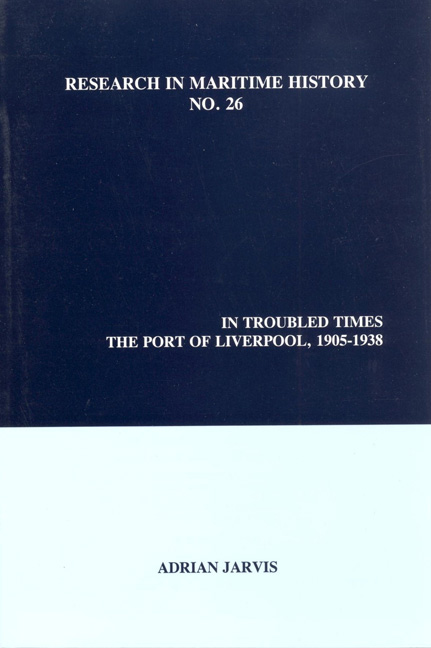Book contents
- Frontmatter
- Table of Contents
- List of Figures
- Foreword and Acknowledgements
- Conversion Factors for Imperial Measurements
- Introduction: The Port of Liverpool in 1905
- Chapter 1 The Port and Its Trade in 1905
- Chapter 2 Gladstone Dock
- Chapter 3 Not Before Time: The Board Keeps its Promise
- Chapter 4 Engineering, Management and Decision-making
- Chapter 5 Making the Customers Happy
- Chapter 6 Sand, Silt and Sewage: The Work of the Board's Dredgers
- Chapter 7 The Provision of Specialist Cargo Facilities
- Chapter 8 Into the Modern World?
- Conclusion: On the Eve of War
- Appendix: Port Efficiency: A Short Methodological Discourse
- A Note on Sources: Abbreviations
- Bibliography
- Index
Chapter 1 - The Port and Its Trade in 1905
- Frontmatter
- Table of Contents
- List of Figures
- Foreword and Acknowledgements
- Conversion Factors for Imperial Measurements
- Introduction: The Port of Liverpool in 1905
- Chapter 1 The Port and Its Trade in 1905
- Chapter 2 Gladstone Dock
- Chapter 3 Not Before Time: The Board Keeps its Promise
- Chapter 4 Engineering, Management and Decision-making
- Chapter 5 Making the Customers Happy
- Chapter 6 Sand, Silt and Sewage: The Work of the Board's Dredgers
- Chapter 7 The Provision of Specialist Cargo Facilities
- Chapter 8 Into the Modern World?
- Conclusion: On the Eve of War
- Appendix: Port Efficiency: A Short Methodological Discourse
- A Note on Sources: Abbreviations
- Bibliography
- Index
Summary
At first sight, then, the physical condition of the Port of Liverpool in 1905 was fairly impressive. Thanks to the new (1901) Sandon Entrance, Canada and Huskisson docks could handle the largest ships in the world and would suffice for such famous ships of the immediate future as Mauretania and Lusitania. The engineering works at Kings and Queens was another success story: they were large and spacious docks but, dating from the late eighteenth century, were shallow and actually the wrong shape for steamships, which needed both wider quays and a higher quay length/water area ratio. Queens had undergone a fairly successful facelift in the early 1890s which more than doubled its typical annual dues income. But the new scheme was much more radical: Kings and Queens became “spine and branch docks.” In the case of Queens, its water area and linear quayage increased by some fifty percent but its earnings increased from £19.67 per yard per year in 1899 to £44.47/yard in 1909 (the first full accounting year after completion of the whole scheme). There was a long and fairly steady rise of the port's total dues income between 1900 and 1907, but it totalled only about twenty percent, making Queens a far above-average earner and at first sight an impressive investment. In fact, of course, what further investigation shows, as common sense would suggest, is that trade at Queens could only grow at a well above-average rate within the overall growth by “stealing” trade from the belowaverage docks within the port. If we were to assume that every last penny of the £204,318 increase in total dues income between 1900 and 1909 was directly and solely attributable to the improvements in dock facilities under the Acts of 1891 and 1898, which represented the investment of over £5,000,000, then the marginal revenue would represent just under three percent on capital, noticeably below the rate at which the Board had borrowed the money to pay for the works. These docks looked good and worked well, but their financial performance was less impressive. Yet again we are reminded of John Bramley-Moore and his statement that it was impossible to operate docks at a profit.
- Type
- Chapter
- Information
- In Troubled TimesThe Port of Liverpool, 1905-1938, pp. 27 - 42Publisher: Liverpool University PressPrint publication year: 2003



